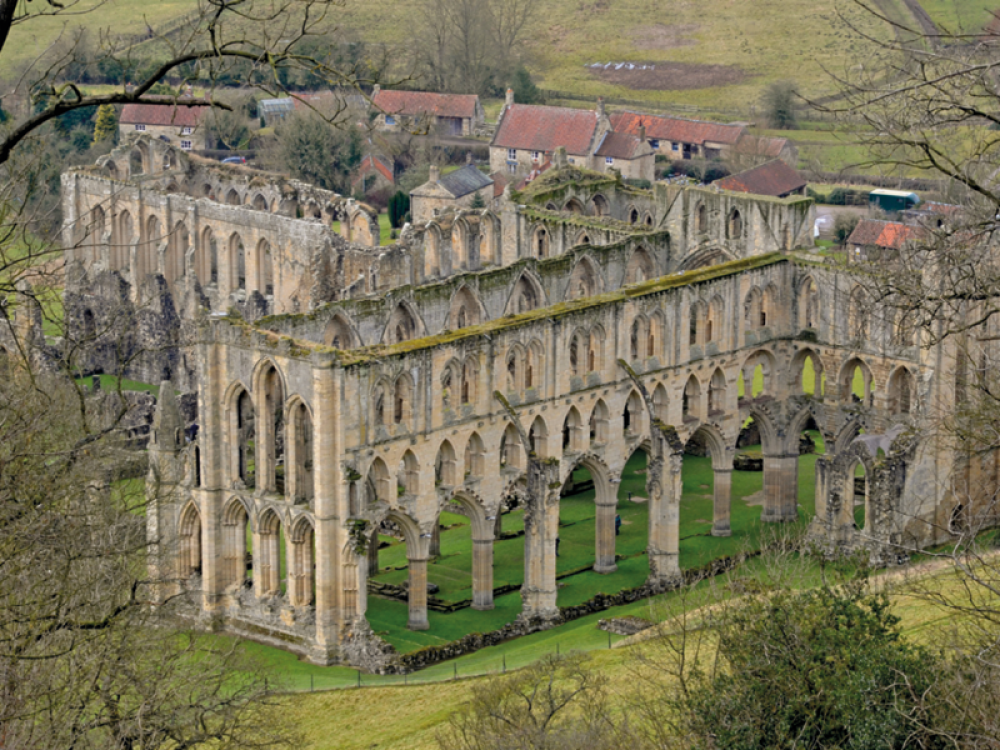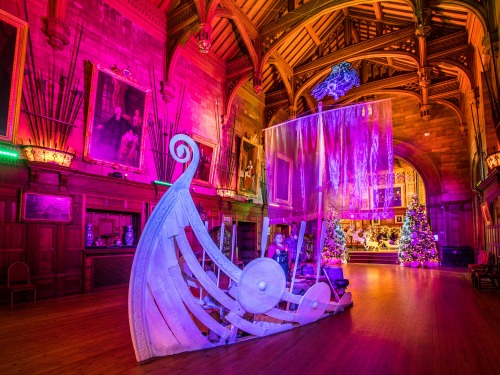Why You Need to Visit North Yorkshire's New Pilgrim Trail this Winter

A brand new pilgrim trail in North Yorkshire links the churches of Upper Ryedale and Helmsley with Rievaulx Abbey
Christmas is often a time for reflection, and what better way to take time out than in the great outdoors of the North York Moors? With bracing fresh air, stunning scenery and a chance to connect with your spiritual side, the new St Aelred’s Pilgrim Trail is a winding path through Upper Ryedale which links more than 10 historic churches, from tiny hidden gems to handsome 19th century creations, and the mighty Rievaulx Abbey.
Although set up as a trail of pilgrimage, Planning Group member for the St Aelred’s Pilgrim Trail George Gyte emphasises that this is something for everyone to enjoy. ‘We wanted it to be both a pilgrimage for people of faith, but also for people of all faiths and no faiths,’ George explains. ‘It’s an opportunity for wellbeing, for meeting people and enjoying the beautiful countryside – so for us it was a matter of just bringing it all together.’

In 2023, the trail originally started as the Upper Ryedale Parish Trail, but expanded this year and was named in honour of St Aelred, the Abbot of Rievaulx Abbey from 1147 until his death in 1167, who was known for his love of walking, history and his writings on friendship – something George feels still resonates today. ‘It’s interesting isn’t it? If you think back to the pandemic, everyone had that sense of wanting to explore a better sense of self and wellbeing, and also explore their spiritual side and existential questions. I think things began with that.’ As well as promoting wellbeing, the trail also holds great historical interest. ‘We were wanting to promote and revitalise interest in our historic rural churches, and rural hamlet churches. We wanted to find a way of interesting and engaging people in that, and in their contribution to our environment, culture and our context.’
St Aelred’s Pilgrim Trail (which also has an adapted route for cyclists and an upcoming bridleway trail for riders) is cyclical, beginning and ending in the picturesque market town of Helmsley. The first leg of the journey starts in St Aelred’s Chapel in All Saint’s Church. ‘This is a magnificent old church. Like the church at Old Byland, it was mentioned in the Domesday Book, so it existed before the Norman invasion,’ George explains. ‘It was redone in the 19th century by one of the great architects of that time, Temple Moore. It’s a beautiful old church with stunning wall paintings and it was natural that we would start there because of the chapel dedicated to St Aelred.’
From Helmsley, the trail takes an easy-going route six miles to the sparsely populated East Moors, the name given to a small stretch of countryside north of Helmsley where you can find the Church of St Mary Magdalene. ‘It’s totally hidden – you could drive by and not see it. It was also built by Temple Moore and was the first he built for the passionate vicar of Helmsley, Charles Grey, who was obsessed with Christianity and health, and felt that he needed to improve the health of the those who lived in and around Helmsley – as well as make sure they knew about God. The church at East Moors was one of the early ones built to cater to the rural farming communities who didn’t have a church. It’s a tiny, immaculate, lovely little church, and it’s still open!’ The church is so lovely that it inspired the 20th century Poet Laureate John Betjeman’s poem Perp. Revival i’the North.

The trail then heads north west along a more moderate route, towards Bilsdale. ‘It crosses Helmsley Moor into Bilsdale West Moor and heads down into Bilsdale. Back in the 19th century, Bilsdale was just a track and there was no road through. Charles Grey persuaded the local earl to put a church there,’ George explains. ‘St John the Evangelist’s Church in Bilsdale is stunningly beautiful and in a lovely setting right at the side of the road. It’s very much a 19th century church and was built in that style.’ From there, the trail veers east and up onto Hawnby Moor. ‘The trail loops around Hawnby Hill and drops down to All Saints’ Church. Hawnby is stunning, and that church sits in an idyllic pastoral scene by the river,’ says George. ‘It was built in the 12th century, and ransacked by the Scots a couple of times when they were marauding down here. It had to be rebuilt in parts, but very much has a 12th century medieval church feel – what I call one of our medieval treasures. It’s a poets’ church – there are poetry books there for visitors to read as well as materials for them to write poems.’
Although the scenery throughout the trail is undeniably beautiful, the highlight, George tells us, is at Murton Grange after climbing up and out of Hawnby. ‘If you turn around you will see one of the most stunning views on the North York Moors. You’ve got the Upper Ryedale Valley, with Hawnby Hill and Easterside Hill shouldering the whole thing – it’s beautiful.’ From there, you reach Old Byland (and another All Saint’s Church, just off the village green). ‘Old Byland has one of the oldest churches in the area, another one that was mentioned in the Domesday Book. It’s still very much a medieval church and has hardly been altered, and still has Saxon elements around it.’

The next church on the trail (St Mary’s) was built at Scawton by monks who had left the area around Rievaulx Abbey after a disagreement with the other monks (ostensibly over the ringing of bells). ‘That church was built by the monks who went on to build the beautiful Byland Abbey. It’s still there, and still stunning. It looks like it did when they were there and it still has a lot of the original features in it. It’s probably the most photographed church in the area.’ This section of the trail is shorter (though still moderate), with only a mile-and-a-half to the next church at Cold Kirby, where you can see the sadly now closed St Michael’s. A beautiful site nonetheless, it sits close to the Cleveland Way in a quiet spot in the village. The font here dates back to the 12th century and one of its remaining bells is from the 13th century.’
Following the marked Cleveland Way down into the valley, and then through Ashberry Woods, you will then have a clear view of the majestic Rievaulx Abbey to your right, and will also be able to visit the nearby Church of St Mary the Virgin, and Rievaulx Methodist Church. For more than 800 years, the nave of St Mary the Virgin served as the ‘slipper chapel’ of the Abbey. ‘The monks who were going to the Abbey stopped there to take their filthy boots off. It was rebuilt and is a beautiful little church now,’ explains George. The impressive ruins of Rievaulx Abbey are all that’s left of this once-grand Cistercian monastery. Over the centuries Rievaulx has experienced many highs and lows, from the height of monastic powers in England to the dissolution of the monasteries under Henry VIII, and the later emergence of the Romantic period which drew heavily upon its ruined and overgrown remains.
Heading south again, the route follows the River Rye down and towards Sproxton, a small village just south of Helmsley (our original starting point) and to St Chad’s church. ‘This church has a fascinating tale,’ George says. ‘Again we’re back to Vicar Grey and his mad ideas. There was a church in a field about a mile-and-a-half away which was derelict, an original Elizabethan church, and he persuaded the Earl of Feversham to move the church brick by brick, stone by stone, from where there was no community, into the village of Sproxton. It’s this tiny church, allegedly the smallest in North Yorkshire, but you go inside and its like a cathedral!
‘The route heads along the Ebor Way, which winds its way back along the river and into Helmsley itself and to the methodist church which is a lovely 19th century building. The route all links up.’
Officially launched in September, the trail features prominent markers throughout to help walkers on their journey, and there are also Pilgrim Passports available from the website or at the churches along the way, so explorers can get a stamp at each church they visit. ‘We had someone who ran it [in one] day, starting at 6am and ending at 4.30pm – all 41 miles! For others, it’ll be a five day, relaxed stand-and-stare walking opportunity, where they can admire the countryside and visit the beautiful old churches that have seen so many families come through generationally.’
For more information on the trail, visit saintaelredspilgrimtrail.com.







